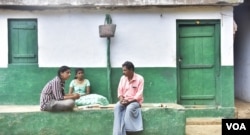Journalists and environmental media networks are teaming up to expand coverage of issues ranging from the effects of extreme weather on farming communities to the damage caused by sand mining.
In India, two veteran journalists — Sharada Balasubramanian and Varsha Singh — are among those looking at how environmental issues are shaping the lives of those in developing countries.
Their coverage has taken them to remote villages, coastal regions, and on high-altitude treks.
Singh says female journalists play an important role in reporting these stories.
“I see this time as a unique opportunity for women in environmental journalism. Ecofeminism,” Singh told VOA. “Women are generally more vulnerable to the impacts of climate change. It's often easier for a female journalist to connect with the vulnerable communities living in rural areas.”
Balasubramanian, a journalist from Coimbatore in southern Tamil Nadu state, says when she started out in journalism, environmental coverage was largely missing in mainstream media.
Then she took a job at Greenpeace. The experience, she said, made her realize that her interest in environmental issues and her reporting skills could be combined.
A Bay of Bengal grant from the Earth Journalism Network, or EJN, in 2018 gave her the support to be able to report from the Andaman Islands.
There, she said, “I covered stories of island farmers impacted by climate change.”
Access to that grant and others enabled her to investigate issues such as wildlife crimes and to cover events like an International Whaling Commission meeting in Slovenia.
"The grants have been immensely helpful to pursue undercovered stories from untold geographies," she told VOA.
Her assignments have taken Balasubramanian to unexpected places. She recalled staying in rustic huts and encountering insects. Another time, she trekked the Rumbak valley in Ladakh. Ladakh is a union territory of India in the Himalayas.
But covering the environment can be risky. The reporter says she has to “be alert, all the time.”
“Of course, one needs to also take precautions, especially as a woman journalist. When we do stories like these, we learn where to be warm, passive and a little cold,” she said. The journalist says she adapts her behavior or tone, and watches closely for body language “as a safeguard.”
Another risk is sometimes politically charged content.
“In the recent times, one needs to also exercise caution while approaching these stories, as (they) could converge with political issues and could potentially harm journalists,” she said.
Media groups like Reporters Without Borders or RSF say the environment for journalism is declining in India. RSF cites attacks, legal action, and pressure from officials among the issues for the country’s media. Journalists who cover illegal environmental activity, such as sand mining, can also be at risk of physical attack.
Balasubramanian’s coverage has caught international attention. An Oxpeckers grant that enabled her to report on a wildlife crime investigation led to an invitation to speak at an event in Geneva.
The European Union event for its Eco Solve project is looking at solutions to the illegal wildlife trade.
“I spoke about India's attempt to go digital in documenting wildlife crimes,” she said.
In her interview with VOA, Balasubramanian underscored the collaborative nature of creating change, attributing any impact to those who act on the information in her stories.
The change coverage can bring is also core to Singh's work. The journalist from Dehradun, in Uttarakhand state, has contributed to outlets including Newsclick, Mongabay Hindi, and BBC Hindi.
Collaborating with international organizations such as EJN and Climate Tracker helped her develop a global perspective on local environmental challenges and events.
“(Once you) brace yourself for the challenges of telling these stories, the world will be yours. I've embarked on some challenging yet remarkable reporting trips through these stories,” she said.
The partnerships allowed her to highlight marginalized communities and their struggles. The goal was to raise awareness globally, putting pressure on regional leadership and policymakers to take action.
"Thanks to grants, training, and mentorship from organizations like the Earth Journalism Network, I've had the opportunity to cover stories from some of India's most marginalized rural areas and bring them to global attention," said Singh.
Founded in 2004 by Internews, the EJN helps journalists from developing countries report more effectively on issues affecting their communities.
Joydeep Gupta, the network’s India manager, says that the fellowships and training have significantly contributed to the ability of journalists like Balasubramanian to adopt a more holistic approach to stories.
In Balasubramanian’s case, the network was able to help by providing resources, including access to contacts and experts.
Globally, the network has trained thousands of journalists, who in turn have produced more than 14,000 stories.
Those stories — and the network’s research — look at everything from conservation efforts to climate mis- and disinformation across Africa.
In India, says Gupta, some of the most impactful projects have looked at the situation in the Bay of Bengal, or the transition to clean energy.
These projects align with the network's mission to enhance journalists' capabilities in delivering more impactful environmental stories, he said.
The collaborative efforts and training of the network, and work of journalists like Balasubramanian and Singh are helping draw attention to core environmental issues while amplifying voices of those most affected.






